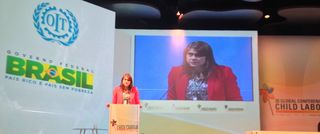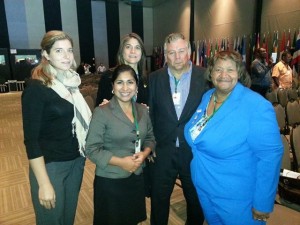Brazil Child Labor Conference Plenary Statement by CLC Member Jo Becker Urges Three Actions
[Jo Becker delivered the following speech October 9, 2013 at the III Global Conference on Child Labor in Brasilia, Brazil].
I’m pleased to be able to speak on behalf of Human Rights Watch. Over the last decade, we have documented child labor in more than 25 countries, in all regions of the world. In hundreds of interviews, we have seen how these children put their health, their educations, their safety and sometimes their lives at risk. We have met children harvesting sugarcane who have gashes on their legs from sharp machetes; children picking tobacco who suffer nicotine poisoning; children who have climbed into deep mining shafts for gold, only to have them collapse; and child domestic workers who travel long distances from their families, only to be beaten and sexually abused by their employers.
We welcome the progress that has been made in reducing the numbers of children in child labor, including its worst forms. However, we are deeply concerned about the 168 million children who are still engaged in child labor, including the 85 million who are in hazardous conditions.
In particular, we want to highlight three situations:
1) Child domestic workers: The new ILO report finds that child labor rates are going down, with one exception – the numbers of child domestic workers increased by over 1 million in the last four years. Hidden in private homes, these children are often excluded from labor laws, at increased risk of abuse, but the least likely to get help.
2) Children in agriculture: In the United States, we have documented how, because of an exception in the child labor law, children who work for hire on farms work at far younger ages, for far longer hours, and under far more hazardous conditions than children in any other job. Like in the US in many countries, children in agriculture become sick from pesticide and nicotine exposure. Despite their huge numbers, they are often overlooked in efforts to end child labor and unprotected by child labor laws.
3) Children in small-scale gold mining: Over 1 million children worldwide work in mining, one of the most dangerous forms of child labor. In Mali, Ghana, and Tanzania, we found children not only digging ore from deep unstable shafts, but also using toxic mercury. Children mix mercury with their bare hands to create a gold-mercury amalgam, and breathe in the toxic mercury fumes when they burn the amalgam to recover the gold. Exposure to toxic mercury can cause irreversible brain damage and puts the lives of these children at risk.





